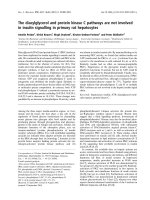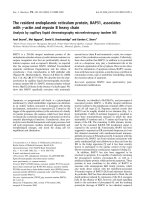Báo cáo khoa học: "The benefits and threats of research partnerships with industry" pps
Bạn đang xem bản rút gọn của tài liệu. Xem và tải ngay bản đầy đủ của tài liệu tại đây (33.33 KB, 2 trang )
309
Available online />During the past two decades, the involvement of non-
academic sponsors of biomedical research, particularly
clinical trial research, has increased exponentially. It is
estimated that between 1980 and 2003 the overall research
and development expenditure by US pharmaceutical
companies increased from $2 billion to $33 billion [1]. The
sources of funding for biomedical research have also shifted
significantly towards industry. By 2002, 70% of funding for
clinical trials came from industry [2]. The involvement of
industry partners in research has undoubted benefits. Drug
development is extraordinarily expensive, and government
and other non-commercial sources of research funding have
generally not been able to or willing to underwrite the
enormous sums necessary to develop and test the
medications and devices that have made remarkable
improvements in the lives of so many.
But partnership with industrial sponsors of research also
carries potential threats both to human subject protection
and to research integrity. Because such research may result
in financial or other rewards for researchers and institutions,
commercially sponsored research may taint individual or
institutional judgment concerning important aspects of the
conduct of research. To the extent that researchers have a
financial interest in the success of the research, such as an
equity interest in the sponsor, or if the researcher has come
to rely upon the sponsor for research funding or for personal
income, the researcher has financial interests that
substantially align with those of the sponsor; that is, for a
successful project with adequate recruitment and positive
results. In an increasingly entrepreneurial environment,
researchers and and/or institutions may own shares, options,
or other interests in biotechnology companies formed for the
purpose of exploiting research findings. Such interests may
cause the investigator, perhaps unwittingly, to recruit
subjects inappropriately, to downplay risks or exaggerate
benefits, to cut corners on inclusion/exclusion criteria, or to
under-report adverse events. Institutions that have come to
rely on industry-sponsored research for overhead payments
and other amounts that support the broader research
enterprise may fail to provide adequate oversight to ensure
appropriate research practices. While the existence of a
financial or non-financial conflict does not itself show
improper behavior, maintaining public trust in the integrity of
scientific investigation and the protection of human subjects
requires that conflicts be carefully managed.
Particular precautions are necessary in critical care to ensure
that appropriate research standards are met. For research in
the intensive care unit there is frequently limited time available
to secure consent, which is often obtained from family
members, and in some emergency research may not be able
to be obtained at all. Even those patients that appear capable
of consenting may have no recollection of their intensive care
unit stay, and family members may be overwhelmed when
asked to make decisions for a patient with acute or life-
threatening illness.
Industrial sponsors of research tend to focus drug and device
development on products for which a market exists or can be
created, not necessarily on products for which there is the
greatest need or social value. Industry-sponsored clinical trials
can be of significant financial benefit to research institutions
and researchers. Institutions’ over-reliance on industry-funded
research may therefore skew the institutional research agenda
by focusing resources, and the talents of institutional
researchers, on studies with commercial applications and
away from other important research avenues.
Institutions and investigators should also be aware of
potential threats to the integrity of industry-sponsored
research. Researchers with ties to industry have been shown
to be more likely to report favorable results than researchers
without such ties [3-5]. In clinical trials, sponsors have a clear
interest in designing a trial that will have the greatest
likelihood of demonstrating a positive result for their product.
Sadly, sponsoring companies have in the past used a variety
of methods to influence aspects of trial design in order to
Commentary
The benefits and threats of research partnerships with industry
Gordon DuVal
University of Toronto Joint Centre for Bioethics, Toronto, Canada
Corresponding author: Gordon DuVal,
Published online: 26 April 2005 Critical Care 2005, 9:309-310 (DOI 10.1186/cc3539)
This article is online at />© 2005 BioMed Central Ltd
310
Critical Care August 2005 Vol 9 No 4 DuVal
make it more likely that research yields the desired results [6].
Surrogate endpoints are measured that may at best be weak
predictors of a relevant health outcome — or particularly
sensitive endpoints, most probably to show a positive
response, may be chosen [7,8]. Inappropriate measurement
scales [9] and a range of other techniques may also be
employed to skew research results in a positive way [10].
Furthermore, data are commonly retained by the sponsor in
multicenter trials, who oversees their analysis and inter-
pretation. In the analysis of data, a number of techniques may
be employed to give the misleading appearance that the
sponsor’s product is superior to others. Calculations may be
based on unrealistically large effect sizes that make data
more likely to show a statistically significant result [11], or
conclusions may be based on statistically insignificant
differences [10] or inappropriate generalizations from findings
[12]. Researchers should be wary also of the bias that may
be introduced in industry’s reporting of findings. Selective or
misleading reports of findings, or conclusions that may not
accord fully with the study data, are not uncommon [13].
Researchers should also ensure that research findings are
not suppressed. Withholding research findings is a violation
of the fundamental goal of medical research, to advance
scientific knowledge in order to cure illness and relieve
suffering [14]. In a 1997 survey, Blumenthal and colleagues
found that 19.8% of academic life scientists had delayed
publication of findings for longer than 6 months at the request
of the sponsor [15]. In an analysis of 30 studies of drug-
related research, Lexchin and colleagues demonstrated that
research funded by drug companies is less likely to be
published than other studies [16].
While research partnerships with industry may bring
significant benefits to researchers and institutions, potential
conflicts must be carefully monitored. Sometimes the
protection and respectful treatment of subjects and the
integrity of research require that some research opportunities
be foregone, or are carried out by independent investigators
elsewhere.
Competing interests
The author(s) declare that they have no competing interests.
References
1. Pharmaceutical Research and Manufacturers of America: 2004
Pharmaceutical Industry Profile. Washington, DC: Pharmaceutical
Research and Manufacturers of America; 2004.
2. Bodenheimer T: Uneasy alliance — clinical investigators and the
pharmaceutical industry. N Engl J Med 2000, 342:1539-1544.
3. Cho MK, Bero LA: The quality of drug studies published in
symposium proceedings. Ann Intern Med 1996, 124:485-489.
4. Davidson RA: Source of funding and outcome of clinical trials.
J Gen Intern Med 1986, 1:155-158.
5. Friedberg M, Saffran B, Stinson TJ, Nelson W, Bennett CL: Eval-
uation of conflict of interest in economic analyses of new
drugs used in oncology. JAMA 1999, 282:1453-1457.
6. Bero LA, Rennie D: Influences on the quality of published drug
studies. Int J Technol Assess Health Care 1996, 12:209-237.
7. Temple R: Are surrogate markers adequate to assess cardio-
vascular disease drugs? JAMA 1999, 282:790-795.
8. Psaty BM, Weiss NS, Furberg CD, Koepsell TD, Siscovick DS,
Rosendaal FR, Smith NL, Heckbert SR, Kaplan RC, Lin D, et al:
Surrogate end points, health outcomes, and the drug-
approval process for the treatment of risk factors for cardio-
vascular disease. JAMA 1999, 282:786-790.
9. Marshall M, Lockwood A, Bradley C, Adams C, Joy C, Fenton M:
Unpublished rating scales: a major source of bias in ran-
domised controlled trials of treatments for schizophrenia. Br J
Psychiatry 2000, 176:249-252.
10. Safer DJ: Design and reporting modifications in industry-spon-
sored comparative psychopharmacology trials. J Nerv Ment
Dis 2002, 190:583-592.
11. Raju TN, Langenberg P, Sen A, Aldana O: How much ‘better’ is
good enough? The magnitude of treatment effect in clinical
trials. Am J Dis Child 1992, 146:407-411.
12. Montaner JS, O’Shaughnessy MV, Schechter MT: Industry-spon-
sored clinical research: a double-edged sword. Lancet 2001,
358:1893-1895.
13. Gotzsche PC: Methodology and overt and hidden bias in
reports of 196 double-blind trials of nonsteroidal antiinflam-
matory drugs in rheumatoid arthritis. Control Clin Trials 1989,
10:31-56.
14. Anonymous: A duty to publish [editorial]. Nat Med 1998, 4:
1089.
15. Blumenthal D, Campbell EG, Anderson MS, Causino N, Louis KS:
Withholding research results in academic life science. Evi-
dence from a national survey of faculty. JAMA 1997, 277:
1224-1228.
16. Lexchin J, Bero LA, Djulbegovic B, Clark O: Pharmaceutical
industry sponsorship and research outcome and quality: sys-
tematic review. BMJ 2003, 326:1167-1170.









